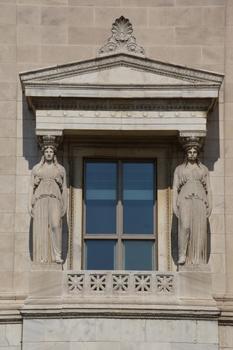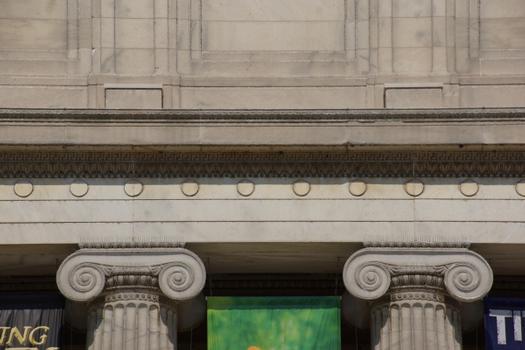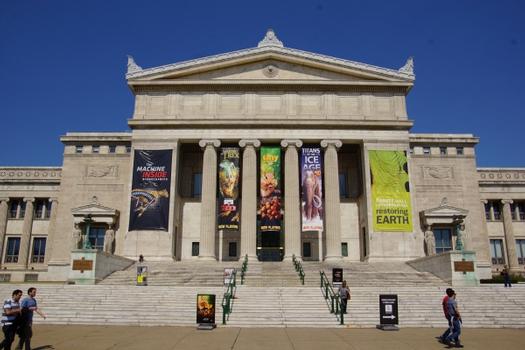General Information
Project Type
| Function / usage: |
Museum building |
|---|---|
| Architectural style: |
Neoclassical |
Awards and Distinctions
| 1975 |
for registered users |
|---|
Location
| Location: |
Chicago, Cook County, Illinois, USA |
|---|---|
| Address: | 1400 South Lake Shore Drive |
| Coordinates: | 41° 51' 58.68" N 87° 37' 1.20" W |
Technical Information
There currently is no technical data available.
Excerpt from Wikipedia
The Field Museum of Natural History (FMNH), also known as The Field Museum, is a natural history museum in Chicago, and is one of the largest such museums in the world. The museum maintains its status as a premier natural-history museum through the size and quality of its educational and scientific programs, as well as due to its extensive scientific-specimen and artifact collections. The diverse, high-quality permanent exhibitions, which attract up to two million visitors annually, range from the earliest fossils to past and current cultures from around the world to interactive programming demonstrating today's urgent conservation needs. The museum is named in honor of its first major benefactor, the department-store magnate Marshall Field. The museum and its collections originated from the 1893 World’s Columbian Exposition and the artifacts displayed at the fair.
The museum maintains a temporary exhibition program of traveling shows as well as in-house produced topical exhibitions. The professional staff maintains collections of over 24 million specimens and objects that provide the basis for the museum’s scientific-research programs. These collections include the full range of existing biodiversity, gems, meteorites, fossils, and rich anthropological collections and cultural artifacts from around the globe. The museum's library, which contains over 275,000 books, journals, and photo archives focused on biological systematics, evolutionary biology, geology, archaeology, ethnology and material culture, supports the museum’s academic-research faculty and exhibit development. The academic faculty and scientific staff engage in field expeditions, in biodiversity and cultural research on every continent, in local and foreign student training, and in stewardship of the rich specimen and artifact collections. They work in close collaboration with public programming exhibitions and education initiatives.
History
The Field Museum and its collections originated from the 1893 World’s Columbian Exposition and the artifacts displayed at the fair.[ better source needed] In order to house for future generations the exhibits and collections assembled for the Exposition, Edward Ayer convinced the merchant Marshall Field to fund the establishment of a museum. Originally titled the Columbian Museum of Chicago in honor of its origins, the Field Museum was incorporated by the State of Illinois on September 16, 1893, for the purpose of the "accumulation and dissemination of knowledge, and the preservation and exhibition of artifacts illustrating art, archaeology, science and history." The Columbian Museum of Chicago occupied the only building remaining from the World's Columbian Exposition in Jackson Park, the Palace of Fine Arts. It is now home to the Chicago Museum of Science and Industry.
In 1905, the museum's name was changed to the Field Museum of Natural History to honor its first major benefactor and to reflect its focus on the natural sciences. During the period from 1943 to 1966, the museum was known as the Chicago Natural History Museum. In 1921, the Museum moved from its original location in Jackson Park to its present site on Chicago Park District property near downtown. By the late 1930s the Field had emerged as one of the three premier museums in the United States, the other two being the American Museum of Natural History in New York and the National Museum of Natural History at the Smithsonian Institution in Washington DC.
The museum has maintained its reputation through continuous growth, expanding the scope of collections and its scientific research output, in addition to the its award-winning exhibitions, outreach publications, and programs. The Field Museum is part of Chicago’s lakefront Museum Campus that includes the John G. Shedd Aquarium and the Adler Planetarium.
Text imported from Wikipedia article "Field Museum of Natural History" and modified on July 23, 2019 according to the CC-BY-SA 4.0 International license.
Participants
-
D. H. Burnham & Company
- Daniel Hudson Burnham (architect)
Relevant Web Sites
- About this
data sheet - Structure-ID
20052810 - Published on:
09/02/2010 - Last updated on:
13/12/2023












